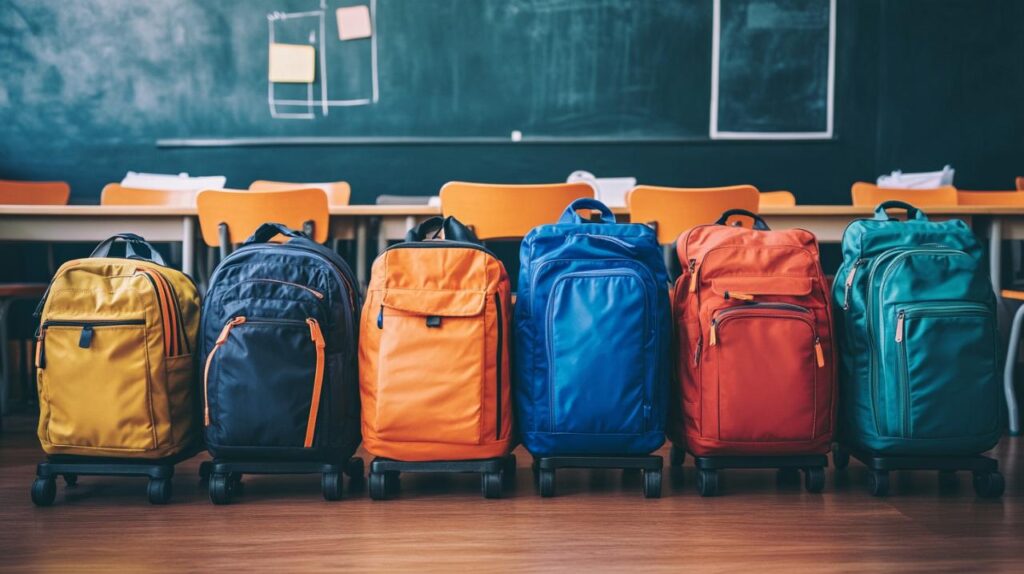As the academic year approaches, parents and pupils alike face the perennial challenge of finding the perfect bag to accommodate textbooks, stationery, and personal items. Traditional rucksacks have long been the staple choice, yet increasing concerns about back health and comfort have prompted many families to explore alternatives. Wheeled school bags offer a practical solution that combines functionality with ergonomic benefits, particularly for children who must transport heavy loads across varying terrains throughout the school day.
Essential Features to Consider When Selecting Rucksacks with Wheels for School
When embarking on the journey to find the ideal wheeled school bag, several critical factors warrant careful consideration. The first step involves understanding the fundamental characteristics that distinguish a high-quality trolley backpack from a substandard option. The durability of materials, the ergonomic design, and the capacity to distribute weight effectively all play pivotal roles in ensuring both longevity and comfort. Many families discover that investing time in evaluating these features ultimately saves money and prevents health complications associated with carrying excessive weight.
Durability and Material Quality for Long-Term Use
The construction materials of a wheeled rucksack determine how well it withstands the rigours of daily school life. Polyester emerges as a preferred choice among manufacturers due to its remarkable resistance to wear and its ability to repel water, protecting valuable contents from unexpected showers. The JanSport Driver8 Backpack exemplifies this commitment to quality, featuring 600D polyester construction that not only resists tears and abrasions but also comes with a lifetime warranty, demonstrating the manufacturer’s confidence in their product’s longevity. Similarly, the High Sierra Freewheel Wheeled Backpack incorporates ripstop polyester with a 600D Duralite coating, offering robust protection whilst maintaining a reasonable price point.
The wheel mechanism itself deserves particular scrutiny when evaluating the best rolling backpacks for school, as this component endures considerable stress throughout its lifespan. Larger wheels measuring seventy-five millimetres or more prove far superior when navigating uneven pavements, cobblestones, or worn school corridors. Some models, such as the Seven TROLLY TYRE HEAVY BOY, specifically incorporate extra-large wheels designed to tackle challenging surfaces with ease. The Kipling rolling backpack range distinguishes itself through the inclusion of spinner wheels, which offer enhanced manoeuvrability in crowded hallways and tight spaces. However, some budget-friendly alternatives, such as the Rockland seventeen-inch Roadster Rolling Backpack, have garnered customer complaints regarding premature wheel and handle failure, underscoring the importance of investing in quality components rather than simply seeking the lowest price.
Ergonomic design and weight distribution
The American Academy of Pediatrics provides clear guidance regarding appropriate backpack weight, recommending that children carry no more than ten per cent of their body weight to prevent back pain, compressed lumbar discs, joint damage, and increased fall risk. This recommendation takes on particular significance when considering the cumulative weight of textbooks, exercise books, and electronic devices that modern pupils routinely transport. Rolling backpacks address this concern by allowing children to pull rather than carry heavy loads, yet they must still include comfortable back-carry options for navigating stairs and crowded hallways where wheeling becomes impractical.
The design of adjustable handles and padded shoulder straps contributes significantly to overall comfort and versatility. The Seven FLY STARS model incorporates an adjustable bar that accommodates growing children, whilst the Osprey Farpoint, recognised as the best overall backpack with wheels at one hundred and seventy-six pounds, balances sophisticated ergonomics with generous capacity. For younger pupils in kindergarten and lower grades, the J World Lollipop Kids Rolling Backpack features dimensions appropriate for smaller frames whilst incorporating appealing design elements such as light-up wheels and an integrated lunch bag. Weight distribution extends beyond mere comfort to encompass posture health, with well-designed trolley backpacks actively promoting better spinal alignment when used correctly.
A Guide to Choosing the Best Wheeled Rucksacks Based on Age and Requirements

Selecting an appropriate wheeled rucksack requires careful consideration of the pupil’s age, physical stature, and specific educational environment. Different life stages necessitate distinct features, with primary school children requiring fundamentally different specifications compared to their secondary school counterparts. Understanding these nuances helps families avoid the common pitfall of purchasing an oversized bag that overwhelms a younger child or selecting an undersized option that proves inadequate for an older student’s needs.
Sizing options for primary through secondary school pupils
Age-appropriate sizing forms the cornerstone of effective wheeled bag selection. For the youngest scholars aged two to four years, bags measuring between twenty and thirty-one centimetres in height provide sufficient capacity without overwhelming small frames. The Perletti model, measuring twenty-nine by thirty-three by eleven centimetres, specifically targets this demographic and thoughtfully includes a plush toy to ease the transition to structured education. Primary school pupils generally require bags between thirty-five and forty-five centimetres in height, with maximum recommended weights of three kilogrammes to prevent strain. The Totto unisex model, measuring thirty-seven by twenty-five by fifty-two centimetres and weighing just two point three kilogrammes, earns high marks for balancing capacity with manageable weight.
As children progress to secondary education, their requirements evolve considerably. Secondary school bags typically exceed forty-five centimetres in height and may accommodate weights up to five kilogrammes, reflecting the increased academic demands and larger textbooks associated with advanced coursework. The Safta Harry Potter Hogwarts model, measuring thirty-two by fourteen by forty-six centimetres and weighing merely one kilogramme, demonstrates that substantial capacity need not translate to excessive weight. The Mountain Warehouse Voyager Wheelie fifty plus twenty offers remarkable versatility for older students who might require additional space for extracurricular equipment or extended trips, whilst the more compact Eastpak Strapverz provides ample room without excessive bulk. For pupils requiring laptop protection, models such as the JanSport Driver8 and Kipling rolling backpacks incorporate dedicated laptop sleeves with protective padding.
Terrain compatibility and wheel mechanisms
The physical environment surrounding a school significantly influences which wheeled bag performs optimally. Urban settings with smooth pavements present fewer challenges than rural locations with gravel paths or historic school buildings featuring worn stone floors. Wheel size directly correlates with terrain capability, with larger wheels rolling more smoothly over obstacles and uneven surfaces. The High Sierra Freewheel Wheeled Backpack, with its thirty-four-litre capacity and reinforced wheel housings, demonstrates how thoughtful engineering addresses diverse environmental conditions. Meanwhile, the Smiggle Epic Adventures Trolley, positioned as the best backpack with wheels for children at thirty-five pounds, balances affordability with adequate performance for typical school environments.
Storage capacity represents another crucial consideration, with measurements typically expressed in litres. The JanSport Driver8 offers thirty-six litres of storage space within dimensions of twenty-one by fourteen by ten inches, whilst the J World Sundance Laptop model provides thirty-eight point three litres. Organisational features such as multiple compartments, zippered pockets, and dedicated spaces for water bottles enhance functionality considerably. The Tilami Rolling Backpack distinguishes itself by including a matching lunch bag, measuring nineteen point two by thirteen point six by nine point eight inches, addressing the practical reality that pupils must transport food alongside academic materials. The Vanguard Veo Select, recommended specifically for photographers at two hundred and eighty pounds, demonstrates how specialised requirements sometimes justify premium pricing through tailored features such as padded camera compartments and customisable dividers.
Regular maintenance extends the lifespan of any wheeled rucksack substantially. Cleaning with mild soap and water prevents dirt accumulation that can compromise fabric integrity and wheel function. Annual lubrication of wheel mechanisms ensures smooth operation, whilst promptly repairing loose seams and malfunctioning zippers prevents minor issues from escalating into major failures. However, recognition of replacement indicators proves equally important, with broken trolley mechanisms, extensive tears, or severely worn wheels signalling that repair no longer represents a viable option. The Mountain Warehouse Voyager Wheelie thirty-five, recognised as the best budget backpack with wheels at fifty-five pounds, exemplifies how quality construction at accessible price points can deliver years of reliable service when properly maintained, ultimately proving more economical than repeatedly replacing inferior alternatives.

